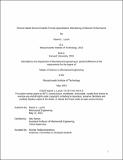| dc.contributor.advisor | Raman, Ritu | |
| dc.contributor.author | Lynch, Naomi L. | |
| dc.date.accessioned | 2023-08-23T16:18:42Z | |
| dc.date.available | 2023-08-23T16:18:42Z | |
| dc.date.issued | 2023-06 | |
| dc.date.submitted | 2023-07-19T18:45:26.411Z | |
| dc.identifier.uri | https://hdl.handle.net/1721.1/151913 | |
| dc.description.abstract | Tissue engineering provides an avenue for improving our understanding of the contractile mechanisms of muscle. 3D engineered muscle models have been developed that mimic the structure and functionality of native muscle. These models have the potential to be used in a wide variety of clinical applications such as neuromuscular disease modeling and drug therapy testing. The contractile mechanisms of engineered muscle are often quantified by constraining the muscle on an elastomeric scaffold and measuring the scaffold’s deformation; however, structural imperfections in the scaffold can negatively impact the accuracy of the recorded contractile data. This paper proposes using a flexure-based device that enables decoding of muscle physiological signals – such as contraction force, contraction time, and relaxation time – in a more precise, reproducible, and automated manner. | |
| dc.publisher | Massachusetts Institute of Technology | |
| dc.rights | Attribution-NonCommercial-NoDerivatives 4.0 International (CC BY-NC-ND 4.0) | |
| dc.rights | Copyright retained by author(s) | |
| dc.rights.uri | https://creativecommons.org/licenses/by-nc-nd/4.0/ | |
| dc.title | Flexure-Based Device Enables Precise Quantitative Monitoring of Muscle Performance | |
| dc.type | Thesis | |
| dc.description.degree | S.M. | |
| dc.contributor.department | Massachusetts Institute of Technology. Department of Mechanical Engineering | |
| dc.identifier.orcid | 0000-0001-8655-7472 | |
| mit.thesis.degree | Master | |
| thesis.degree.name | Master of Science in Mechanical Engineering | |
